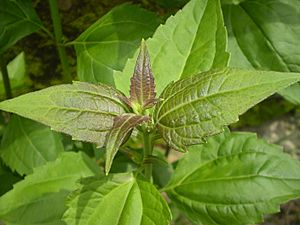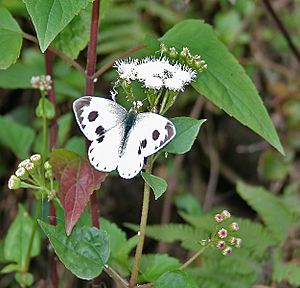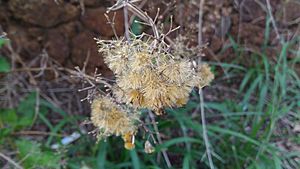Chromolaena odorata facts for kids
Quick facts for kids Chromolaena odorata |
|
|---|---|
 |
|
| Scientific classification | |
| Synonyms | |
|
Synonymy
Chrysocoma maculata Vell.
Chrysocoma maculata Vell. Conc. Chrysocoma volubilis Vell. Conc. Eupatorium brachiatum Sw. ex Wikstr. Eupatorium clematitis DC. Eupatorium conyzoides Mill. Eupatorium dichotomum Sch.Bip. Eupatorium divergens Less. Eupatorium floribundum Kunth Eupatorium graciliflorum DC. Eupatorium klattii Millsp. Eupatorium odoratum L. Eupatorium sabeanum Buckley Eupatorium stigmatosum Meyen & Walp. Osmia atriplicifolia (Vahl) Sch.Bip. Osmia clematitis (DC.) Sch.Bip. Osmia divergens (Less.) Sch.Bip. Osmia floribunda (Kunth) Sch.Bip. Osmia graciliflora (DC.) Sch.Bip. Osmia graciliflorum (DC.) Sch.Bip. Osmia odorata (L.) Sch.Bip. |

Chromolaena odorata is a type of flowering shrub. It grows in warm, tropical, and subtropical areas. This plant belongs to the sunflower family. It originally comes from the Americas. You can find it from Florida and Texas in the United States all the way south through Mexico and the Caribbean to South America.
Over time, this plant has also spread to tropical Asia, West Africa, and parts of Australia. People call it by many different names. Some common names include Siam weed, Christmas bush, devil weed, and triffid. In Malayalam, it's known as Communist Pacha (കമ്മ്യൂണിസ്റ്റ് പച്ച). In the Igbo language, it's called Abani di egwu.
Contents
What Does Chromolaena odorata Look Like?
Chromolaena odorata is a plant that grows very quickly. It is a perennial herb, meaning it lives for more than two years. In open areas, it grows as a shrub with many stems. It can reach up to 2.5 meters (about 8 feet) tall. The stems are soft, but the bottom part of the plant is woody.
If it grows in shady places, it becomes a creeper. This means it climbs on other plants and can grow up to 10 meters (about 33 feet) high. The plant is hairy and has small glands. If you crush its leaves, they give off a strong, pleasant smell.
Leaves and Flowers
The leaves grow opposite each other on the stem. They are shaped like triangles or ovals and have jagged edges. Each leaf is usually 4 to 10 centimeters (about 1.5 to 4 inches) long. They are also 1 to 5 centimeters (about 0.4 to 2 inches) wide. The stalks that connect the leaves to the stem are 1 to 4 centimeters long.
The flowers are white or light pink and shaped like tubes. They grow in clusters called panicles at the ends of the branches. Each cluster has 10 to 35 flowers.
Seeds
The seeds are small and somewhat hairy. They are called achenes. Most of the seeds are carried by the wind. However, they can also stick to animal fur, clothes, or machinery. This helps them travel long distances. A single plant can produce about 80,000 to 90,000 seeds. These seeds need light to sprout and grow. The plant can also regrow from its roots. In good conditions, this plant can grow more than 3 centimeters (over an inch) every day!
How is it Classified?
This plant was once grouped under the genus Eupatorium. However, scientists now believe it is more closely related to other plants. It is now placed in a different group called the Eupatorieae tribe.
What is it Used For?
People have found several uses for Chromolaena odorata. For example, in Nigeria, it has been used in traditional medicine. It can also help fight fungi and tiny worms called nematodes. Farmers sometimes use it as a "fallow species." This means they let it grow on land that is resting from farming. It can help improve the soil's richness in a farming method called slash-and-burn. These uses have helped the plant spread in some areas.
Why is it an Invasive Species?
Chromolaena odorata is considered an invasive weed. This means it grows quickly and can take over areas where it is not native. It causes problems for farm crops and natural environments. In Africa, it is one of the most serious invasive plants in protected rainforests.
In West Africa, it stops new trees from growing in areas where people practice shifting cultivation. In southern Africa, it reduces the variety of plant species. The plant is also very flammable, which can make forest fires worse near the edges of forests. In Sri Lanka, it is a big problem in disturbed areas and coconut farms.
How is it Controlled?
People have tried different ways to control Chromolaena odorata. In the 1970s, scientists tried to use a type of moth called an artiid. This moth eats the leaves of the plant.
In the Ashanti region of Ghana, a moth called Pareuchaetes pseudoinsulata was brought in. It helped control the plant in a small study. In 2014, there was a call for more efforts to use natural enemies to control the plant in Nigeria. The goal is to bring the plant back into a natural balance.
In Australia, a plan has started to get rid of the plant using special plant-killing chemicals called herbicides. Also, a type of fly called Cecidochares connexa was brought to Guam from Indonesia in 1998. This fly causes galls (lumps) to form on the plant. These galls take away energy from the plant's growth, which helps to weaken it.
How Did it Spread?
In the 1800s, Chromolaena odorata escaped from botanical gardens. This happened in places like Dhaka (India), Java (Indonesia), and Peradeniya (Sri Lanka). In West Africa, the plant was accidentally brought in with tree seeds used for forestry.
In Southern Africa, it was brought in as an ornamental plant, meaning it was grown for its beauty. It was also introduced to Ivory Coast in 1952 to help control certain grasses. In Queensland, Australia, it was first found in 1994. It might have arrived with foreign pasture seeds. In the southern Indian state of Kerala, people call it Communist Pacha. This name came about because the plant spread there in the 1950s, which was when communist leaders formed a government in the state.
Is it Harmful?
Chromolaena odorata contains certain chemicals that can be harmful. It is known to be toxic to cattle. It can also cause allergic reactions in some people. However, recent studies have shown that the plant can also kill the larvae of major mosquito types. This means it could help control mosquitoes.
Images for kids
See also
 In Spanish: Albahaquilla de Cuba para niños
In Spanish: Albahaquilla de Cuba para niños





